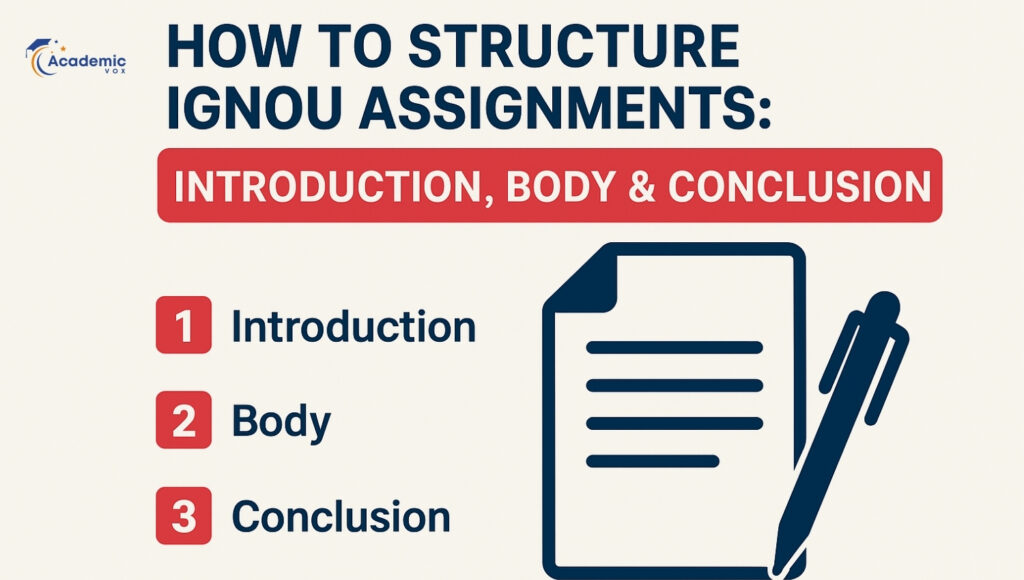Introduction, Body & Conclusion

- Importance of Structure in IGNOU Assignments
While doing writing assignments, most students think only about collecting material. Presentation and structure are also as crucial. An effectively structured assignment:
Makes it easy for answers to be understood.
Brings out your knowledge step by step.
Creates a professional academic impression.
Minimizes possibilities of confusion or misinterpretation.
Ensures the examiners find the main points easily.
Imagine your assignment as a story with a beginning, middle, and end. The introduction introduces the setting, the body evolves the concepts, and the conclusion ties it all up.
- Overall Guidelines Prior to Organizing Your IGNOU Assignment
Prior to writing down introduction-body-conclusion, consider the following general guidelines:
Handwriting: Write in clear and legible handwriting. Don’t over-write.
Paper Format: Utilize A4 ruled paper with appropriate margins.
Word Limit: Adhere to the recommended word limit (typically 500–700 words per answer unless stated otherwise).
Referencing: Include references at the end of each answer where necessary.
Language: Formal, academic tone is to be used. No casual or slang terms.
- Comprehending the Structure: Introduction, Body & Conclusion
Each IGNOU assignment answer must ideally have a 3-part structure: A. Introduction (10–15% of the Answer)
Gives a brief overview of the topic.
Defines key terms and concepts.
States your answer’s purpose.
B. Body (70–80% of the Answer)
Principal section where you describe, analyze, and give reasons.
Break into headings, subheadings, and bullet points for clarity.
Support your points with examples, case studies, and references.
C. Conclusion (10–15% of the Answer)
Summarizes the key points.
Provides closure without adding new information.
May include personal opinion or future scope in brief.
- How to Write a Perfect Introduction in IGNOU Assignments
Introduction is your first impression. Here’s how you can strengthen it:
Begin with a definition or context
For instance, if the question is on globalization, start with a definition of globalization and its origin.
Put the question in context: Connect the idea to real-world situations or scholarly debates.
Indicate your method: Say how you are going to answer the question (e.g., by examining causes, effects, and solutions).
Example Introduction
Globalization is the widening of connections between nations through trade, communication, and cultural interaction. In the last few decades, globalization has revolutionized economies, societies, and political systems. In this response, we will be considering the primary effects of globalization in developing countries with special reference to economic, cultural, and political dimensions.
- How to Write the Body of IGNOU Assignments
The body is the central part of your response and must have a logical sequence.
Instructions for Writing the Body:
- Divide into subheadings: For instance, if the subject is “Impact of Climate Change,” use subheadings such as Economic Impact, Social Impact, Environmental Impact.
- Provide examples: Connect the theory to actual cases.
- Offer critical analysis : Don’t merely describe—analyze.
- Use bullet points where appropriate : Makes it easy to scan your work for examiners.
- Balance word count: Don’t let one section be extremely long while neglecting others.
Example Structure of Body for Question on “Digital Education in India”:
Introduction
Growth of Digital Education
Government Initiatives
Advantages (Accessibility, Flexibility, Cost-Effectiveness)
Challenges (Digital Divide, Quality of Content, Infrastructure Issues)
Case Studies (e.g., SWAYAM, DIKSHA platforms)
- How to Write the Conclusion in IGNOU Assignments
Your conclusion must not seem like a cliffhanger. It must transition your arguments smoothly.
What to Put in the Conclusion:
Summary of the key points raised.
Do not raise new arguments.
Add a final thought, future outlook, or solution.
Sample Conclusion for “Climate Change” Question:
“In summary, climate change is not just an environmental problem but a socio-economic challenge that needs to be addressed on a global level. Unless drastic action is taken immediately to stem its tide, future generations can suffer irreparable damage. Thus, sustainable development is the only option.”
- Sample Structured Answer for IGNOU Assignment
Let’s consider an example question:
Question: Discuss the role of women in rural development.
Introduction
Define rural development and women’s participation.
Role of women in developing rural economies.
Importance of women in forming rural economies.
Body
- Economic Role – Agriculture, cottage industries, self-help groups.
- Social Role – Education, health, community welfare.
- Political Role – Involvement in Panchayati Raj, decision-making.
- Challenges – Gender discrimination, illiteracy, restricted mobility.
- Government Initiatives Schemes such as NRLM, Beti Bachao Beti Padhao.
Conclusion
Summarize the multi-dimensional role of women.
Highlight the importance of empowerment and equal opportunities.
- Common Mistakes to Avoid in Structuring Assignments
Writing overly long introductions that consume word count.
Copying and pasting from study material without interpretation.
Omitting conclusion or writing it too briefly.
Poor penmanship or presentation.
Ignoring citations and references.
- How to Score Higher in IGNOU Assignments
Adhere to IGNOU format, cover page, and word limit guidelines.
Use simple and clear language and avoid unnecessary jargon.
Proofread always before final submission.
Include examples, diagrams, and flowcharts wherever applicable.
Have a balanced format for all the answers. - Final Thoughts
Having a proper Introduction, Body, and Conclusion in IGNOU assignments is of prime importance to get high marks. It not only makes reading easier but also displays your comprehension of the topic. Keep in mind, examiners like clarity, flow, and analysis more than long, disorganized answers.
So the next time you are getting your assignment ready, adopt this systematic approach and notice the difference it will make to your assessment.
